A look inside Gregor Bruhn's workshop
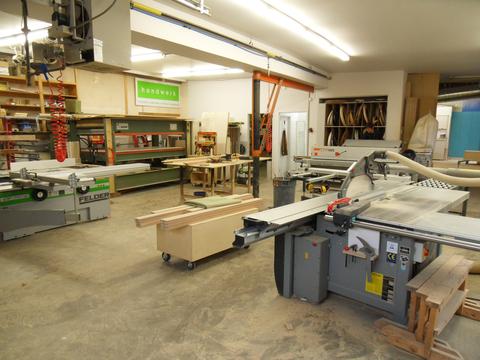
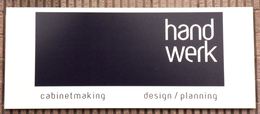 I recently had a chance to have a look at Gregor Bruhn's workshop.
Gregor Bruhn is a professional cabinetmaker in Ottawa, and he runs
a business called "hand werk", making
high end cabinetry in the Ottawa area.
I recently had a chance to have a look at Gregor Bruhn's workshop.
Gregor Bruhn is a professional cabinetmaker in Ottawa, and he runs
a business called "hand werk", making
high end cabinetry in the Ottawa area.
What's interesting about his workshop is how it takes a completely different
direction from most hobby workshops. Certainly, if all you read is
woodworking magazines, you would have very different expectations of what
a professional cabinet shop looks like.
 A major difference is that Gregor is a German guy
who immigrated to Canada only three years ago, and his workshop, work
methods and furniture are more aligned with what is commonly done there.
A major difference is that Gregor is a German guy
who immigrated to Canada only three years ago, and his workshop, work
methods and furniture are more aligned with what is commonly done there.
Germans are very attentive to detail in how they build and furnish their houses.
Every time I come back from Germany, it feels like we live in poorly made
shacks here in Canada by comparison.
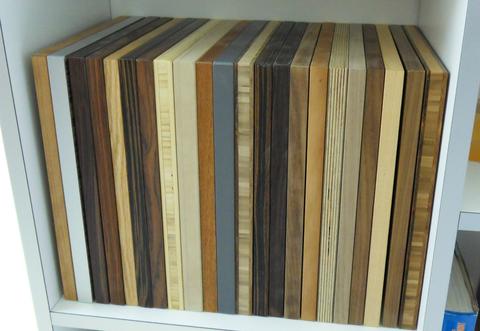 Good quality starts with good materials. Gregor often uses baltic birch
plywood panels for furniture. Also, he sometimes these interesting
plywood-like sheets of laminated bamboo. These panels are quite expensive and aren't
available in your typical home renovation center.
Good quality starts with good materials. Gregor often uses baltic birch
plywood panels for furniture. Also, he sometimes these interesting
plywood-like sheets of laminated bamboo. These panels are quite expensive and aren't
available in your typical home renovation center.
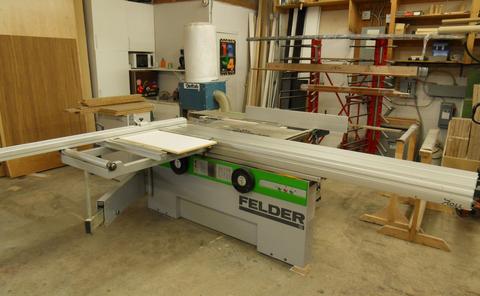 Cabinets are mostly made of panels, and most of the equipment is focused
on working with panels. And the ideal tool for working with panels is a
"format"-style table saw. This is one is a Felder combination machine, with a
jointer / planer part on the other side and a retractable
shaper spindle behind the sawblade. It's used as a table saw though.
Cabinets are mostly made of panels, and most of the equipment is focused
on working with panels. And the ideal tool for working with panels is a
"format"-style table saw. This is one is a Felder combination machine, with a
jointer / planer part on the other side and a retractable
shaper spindle behind the sawblade. It's used as a table saw though.
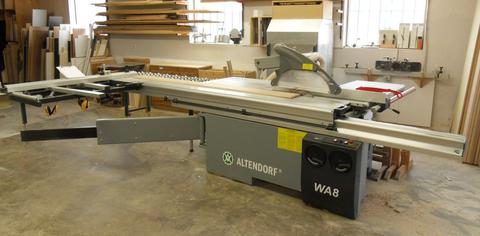 Gregor also has a second, larger, Altendorf format-style table saw.
You wouldn't see what we call a "cabinet maker's saw" such as a Unisaw,
or even a Sawstop in a professional setting in Germany. These types of
saw are considered unsafe, as one tends to stand mostly in front of the
saw to operate it. Format-style table saws are designed to be operated from the side,
and large sheet goods are usually placed on the sliding table.
If one needs to cut up a 4x8 sheet of plywood, that would usually be done
by placing it on the sliding table and moving with the table,
rather than standing behind the saw pushing the sheet through
along the rip fence. The saw's sliding table has enough travel
to rip a full sheet lengthwise.
Gregor also has a second, larger, Altendorf format-style table saw.
You wouldn't see what we call a "cabinet maker's saw" such as a Unisaw,
or even a Sawstop in a professional setting in Germany. These types of
saw are considered unsafe, as one tends to stand mostly in front of the
saw to operate it. Format-style table saws are designed to be operated from the side,
and large sheet goods are usually placed on the sliding table.
If one needs to cut up a 4x8 sheet of plywood, that would usually be done
by placing it on the sliding table and moving with the table,
rather than standing behind the saw pushing the sheet through
along the rip fence. The saw's sliding table has enough travel
to rip a full sheet lengthwise.
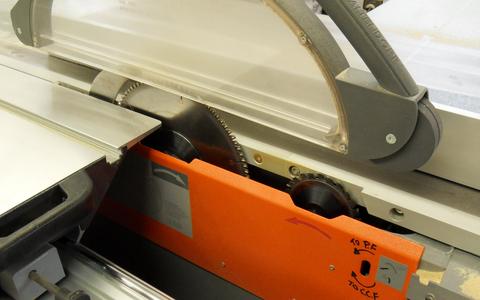 Of course, saws like that don't come cheap, although, apparently,
the Altendorf saw that Gregor has can be bought for about 11,000 Euro
in Germany, much less than one would pay for it here.
Still much more
expensive than the best cabinet saw you can buy, but it's a different
culture with respect to cabinet making in Germany.
Gregor's Altendorf WA8 saw is actually the second smallest model from
Altendorf.
Of course, saws like that don't come cheap, although, apparently,
the Altendorf saw that Gregor has can be bought for about 11,000 Euro
in Germany, much less than one would pay for it here.
Still much more
expensive than the best cabinet saw you can buy, but it's a different
culture with respect to cabinet making in Germany.
Gregor's Altendorf WA8 saw is actually the second smallest model from
Altendorf.
There's a bit more money for that sort of thing in Germany because
there's a bigger market for custom furniture.
Houses are considered "forever" and home improvements
are primarily for one's own satisfaction. Germans don't calculate
"I shouldn't spend more than X dollars on this renovation because it will
only add Y dollars to my house's resale value"
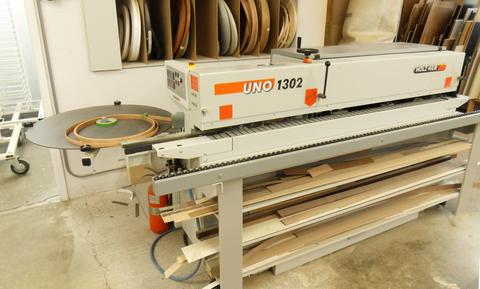 So home furnishings are approached differently,
and there is a bigger market for custom work, the kind that people
in North America would classify as "high end".
So home furnishings are approached differently,
and there is a bigger market for custom work, the kind that people
in North America would classify as "high end".
Some kitchen cabinets by handwerk
So it is no surprise that Gregor focuses on high quality
high end custom work.
When you consider the quality, fit and finish of his work, the price is
not out of line. It's very different from the "cheap as possible"
run-of-the-mill type cabinets that builders will install when they build
whole subdivisions.
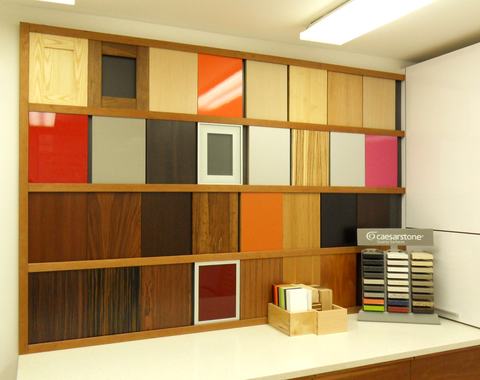 It's also interesting to see different styles. The European fashion
is to have flat cabinet doors. You really don't see many raised panel doors
on new European kitchens these days. They are all flat. They may use all
kinds of interesting exotic surfaces, but they are flat. And I have to say,
I often wish the doors in my own kitchen were flat - especially every time I spill
something off my counter and onto the doors! Why do we get so caught up
on these "traditions"? Why do we need to have painted white cabinet doors
made from MDF, with a groove routed in them to badly imitate a raised
panel door?
It's also interesting to see different styles. The European fashion
is to have flat cabinet doors. You really don't see many raised panel doors
on new European kitchens these days. They are all flat. They may use all
kinds of interesting exotic surfaces, but they are flat. And I have to say,
I often wish the doors in my own kitchen were flat - especially every time I spill
something off my counter and onto the doors! Why do we get so caught up
on these "traditions"? Why do we need to have painted white cabinet doors
made from MDF, with a groove routed in them to badly imitate a raised
panel door?
 Europeans also like things with straight lines, quite often more angular.
And this is apparent not just in
their furniture, but the machines as well. The typical 14" cast iron frame
bandsaw seen here will have the corners of the enclosure rounded.
Not so for European machinery. I have never seen a bandsaw in a European context
that didn't have a square enclosure.
Europeans also like things with straight lines, quite often more angular.
And this is apparent not just in
their furniture, but the machines as well. The typical 14" cast iron frame
bandsaw seen here will have the corners of the enclosure rounded.
Not so for European machinery. I have never seen a bandsaw in a European context
that didn't have a square enclosure.
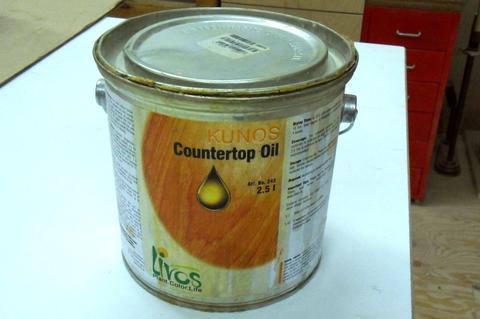 On talking about finishes, I mentioned that "I always just use this water based varnish
to finish everything". Gregor's response "You know, that stuff is just as toxic
as the solvent based finishes, the main difference is that it doesn't smell as bad, but
it will offgas the same and both are toxic to the environment to produce".
If customers want, they use a lacquer finish - only low VOC, low HAPs, 2 component
solvent based lacquers (less offgassing once cured).
"Most of our finishes are with organic natural hard oil/waxes from
LIVOS (no petrochemicals) 100% nature", Gregor adds.
Germans are much more careful and aware of chemical usage.
On talking about finishes, I mentioned that "I always just use this water based varnish
to finish everything". Gregor's response "You know, that stuff is just as toxic
as the solvent based finishes, the main difference is that it doesn't smell as bad, but
it will offgas the same and both are toxic to the environment to produce".
If customers want, they use a lacquer finish - only low VOC, low HAPs, 2 component
solvent based lacquers (less offgassing once cured).
"Most of our finishes are with organic natural hard oil/waxes from
LIVOS (no petrochemicals) 100% nature", Gregor adds.
Germans are much more careful and aware of chemical usage.
More photos in Gregor's workshop
Gregor's website: Handwerk.ca
See also:
Back to my Woodworking website.
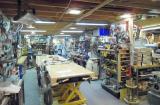 Jacques Jodoin's workshop
Jacques Jodoin's workshop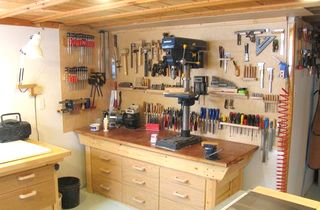 My basement workshop
My basement workshop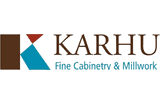 Touring Karhu fine cabinetry and millwork
Touring Karhu fine cabinetry and millwork My dad's workshop
My dad's workshop